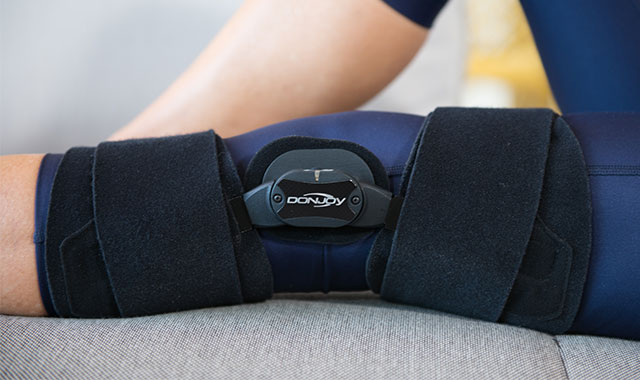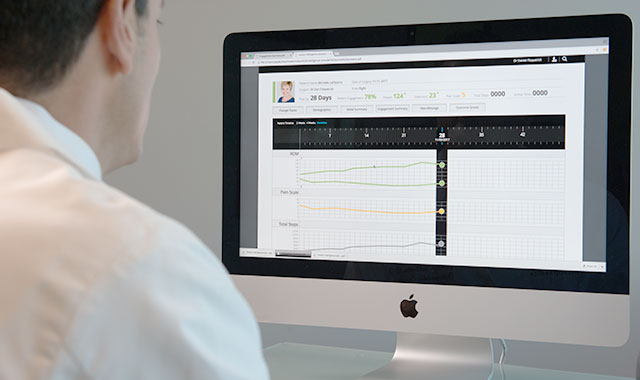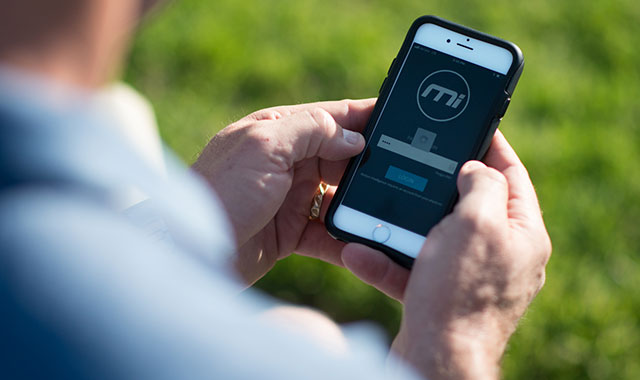Orthopedic surgeons have to look beyond the procedure. The particulars continue to shift, but there’s little question that future healthcare models — driven by trends in reimbursement schemes — will demand greater care and consideration for a patient’s recovery process following surgery.
Even as surgeons and other healthcare professionals have increased responsibility for the ongoing well-being of the patient, the length of hospital stays are shrinking. That means patients spend less time under the direct supervision of medical personnel. Shorter spans before discharge also lead to less opportunity for instruction on the rehabilitation exercises patients must undertake at home in order to maximize recovery.
Surgeons can’t follow patients home, but shrewd application of current technologies might be able to provide the next best thing.
“One of our goals with the X4 smart brace is to help continue the surgeon/patient connection during the time between surgery and follow up visit,” says Kevin Brothen, vice president of global marketing at DJO. “Also during this phase, there is an opportunity for a clinician to intervene and mitigate risk when issues arise.”

The sensor for the brace is built into the hinge and collects data continuously. (Image credit: DJO)
DJO already had an array of software systems designed to help healthcare professionals collect vital data in a streamlined fashion. The key was adapting the products to address the needs surrounding patients recovering from surgery.
The foundation of MotionMD software was an inventory management solution. Because of that genesis, DJO was able to easily integrate the software with existing electronic management record (EMR) platforms as it eventually evolved to also include tracking of patient compliance with assigned physical therapy protocols.
The sensor for the brace is built into the lateral hinge. Using Bluetooth wireless technology, the sensor feeds information to an app on the patient’s phone.
“Regardless of whether or not the app is open, the brace is collecting data,” notes Mike Moore, director of R&D for new product development at DJO. “It’s collecting ambulation data, flexion and extension angles, step counting. That’s happening in the brace.”
When the information is transferred to the app, it also makes its way to the healthcare facility’s data management platform.
“Since you have a patient already in the system, the patient’s information automatically uploads,” explains Brothen. “It doesn’t have to be re-entered and all that information that’s gathered during that postoperative protocol can drop directly into the EMR, so it’s automatically integrated.”

Healthcare providers have ready access to data tracking the recovery process. (Image credit: DJO)
In addition to collecting and transferring data, the app holds key information to the patient. A physical therapy protocol is preloaded onto the app, providing instruction in a way that’s clear and intuitive.
“What we’ve been able to do is create this exercise therapy program that they would do twice a day,” says Brothen. “It basically walks them through the therapy. It gives them a written description of how to do the exercise. If they’re not familiar with how to do the therapy — how to do an individual exercise — they can click on a button and the app provides a video of a physical therapist in a comforting setting, with a really soft, comforting voice, which we realize is important to give the patient confidence that he or she is performing the exercise correctly. He actually does a demonstration of the exercise, with a patient, for them.”
The strategy is to employ every tool possible to strengthen compliance. Better compliance leads to better outcomes, which in turn means a clear path to reimbursement for the healthcare provider.
The app also provides direct, simple feedback to the patient, keeping them fully invested in their progress, even after they’ve crossed healing markers that might make them feel complacent. The pain and discomfort have receded, so they could have the mistaken belief that they’ve further along than they really are. If their commitment to the protocol starts to lag, the app will offer a signal. Basic red, yellow, and green indicators track progress, though patients can dig a little deeper and get more intricate data on number of steps taken, active time, and even average flexion and extension numbers.

Patients can consult an associated app to stay on track with recovery protocols. (Image credit: DJO)
Back at the healthcare facilities, physicians can see all the data in a format that allows for a quick look at all of their patients as well as the ability to drill deeper into individual progress.
The automatic connectivity between patient and physician is also leveraged to create a useful feedback loop.
“If a patient has a question about anything, they can actually send a message and the clinic will be alerted and they’ll able to message back and forth,” Brothen notes. “We feel like that helps the surgeon feel comfortable about the patient leaving and helps the patient feel like they’re still connected to the clinic.”
Knowing that incisions often prompt concern in patients, DJO set up the app to easily facilitate the patient taking pictures and sending the images to the doctor to examine.
For this all to work, of course, the brace needs to stay on and operational. One way to achieve this is by making the device as unobtrusive and comfortable as possible. And the less tinkering the better.
“The device has very little fiddle factor,” says Moore. “It’s battery operated, but the battery is not rechargeable. It fully functions for six months. That is two times the standard TKA protocol.”
Orthopedic surgery patients may only stay in the healthcare facility for a day or less, but the solution built by DJO keeps the recovery process under the surgeon’s watchful eye, no matter the distance.
A version of this article appears in the November/December 2018 issue of Surgical Products.




